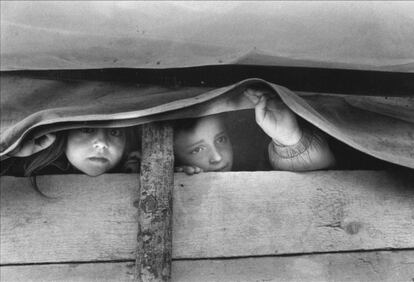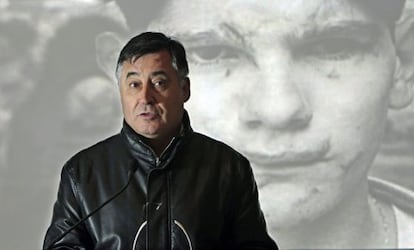Photographer who gives suffering a name and face
Subject of a retrospective in Madrid, the work of Gervasio Sánchez reveals a profound humanity

The Gervasio Sánchez retrospective, which opened on March 6 at the Tabacalera arts center in Madrid, brings together 148 photographs from 20 war-torn countries in Africa, Asia, Europe and Latin America. Taken over the last quarter of a century, the pictures reveal a profound humanity, in spite of the horror they capture.
Sánchez, who won the 2009 National Photography Prize, sees his work as more than just documenting conflict, and has spoken out on many occasions to denounce the West’s refusal to accept its responsibility for perpetuating war in so many parts of the world, either through political interference or simply by selling arms. The way to raise awareness, he says, is to give the suffering a human face and name.
“This is Samuel, who had his hands and tongue cut off in Freetown in 1999,” he says as we inspect the exhibition. “These girls were playing inside a van destroyed in the fighting in Sarajevo in 1994.” He points to the girl on the right of the photograph. “I was able to find her 15 years later,” he says. “She was wearing the same hat. She was fine.”
Next to it is one of the war’s most iconic photographs — of Sarajevo’s library, which was destroyed following a direct hit by a Serbian incendiary bomb in 1993. It’s one of the few images in the exhibition with no people in it.
“Another attempt to destroy a people’s collective memory, one of so many in the long list humanity has perpetrated over the years,” says Spanish writer Juan Goytisolo. “Gervasio Sánchez’s photo captures to perfection the horror and desolation of the place: the metal structuring of the glass dome that the rockets fell through is like a gigantic spider’s web filtering the light; the pillars in the interior patio have lost almost all their plaster; and the central area is a pile of rubble, beams and burnt paper. But as the poet told his interrogators, ‘You can burn my books, but not the spirit that they contain’.”

Visitors entering the exhibition, which has been organized by the Ministry of Education, are greeted by the sound of explosions on a loop. The recording was made by veteran Spanish war correspondent Alfonso Armada in Sarajevo. They then move chronologically through to Latin America, the Balkans and Africa. Two final sections address the impact of mines on the lives of civilians in post-conflict countries such as Mozambique and Cambodia, and on the victims of forced disappearances.
Sánchez, 51, travelled to Latin America in 1984, covering conflicts in Nicaragua, El Salvador and Guatemala, as well as Chile, Panama, Peru and Colombia. As with all his subsequent work, there is a poetic quality to many of the photographs, even though his job was simply to capture what was going on.
He tells the story of meeting a young boy in El Salvador, who asked Sánchez which country he was from, and then with which country it was at war. “When I told him we weren’t at war, he didn’t believe me, and asked what it was like to live in a country without conflict,” says Sánchez.
When I told him my country wasn’t at war with anyone, he didn’t believe me"
Between 1991 and 2004, he traveled to the Balkans, as well as to Africa, covering the wars that tore the former Yugoslavia apart, as well as the genocide in Rwanda and the civil wars in Liberia and Sierra Leone, where so many of those fighting were children, recruited by militias.
Standing before a photograph of a young girl, surrounded by hundreds of dead cholera victims on a road in the Democratic Republic of Congo, he says he and Alfonso Armada counted more than 1,500 bodies on the road out of the capital of Goma as civilians fled fighting that killed up to five million people during the 1990s.
“The cholera victims died because even the most basic treatment wasn’t available. Children were lying on the side of the road, looking at you as you photographed them. A few minutes later, they were dead. You could choose who to photograph, and wait for the right light; nobody was going to bother you.”
In 1995 he turned his attention to the plight of rural communities living in areas that had been mined, and had not been cleared. He decided to document the lives of three individuals directly affected by the problem: Sohkheurm Man in Cambodia; Adis Smajic in Bosnia; and Sofia Elface Fumo, a young woman from Mozambique whose legs were blown off while she was out looking for firewood. Sánchez first photographed her in 1997, returning a decade later. That image won him the 2007 Ortega y Gasset journalism prize.
Much to the discomfort of the government officials present at the subsequent award ceremony, Sánchez took advantage of the occasion to deliver a speech condemning the Spanish government for its sale of weapons such as mines and cluster bombs.
The final section of the exhibition puts a name and a face to the thousands of people forcibly disappeared in countries such as Nicaragua, El Salvador, Guatemala, Chile, Panama, Peru and Colombia — as well as the victims of Franco’s forces during and after the Spanish Civil War.
“Conflicts do not end just because the politicians say they have,” he says. “They end when their consequences do too.”
Tu suscripción se está usando en otro dispositivo
¿Quieres añadir otro usuario a tu suscripción?
Si continúas leyendo en este dispositivo, no se podrá leer en el otro.
FlechaTu suscripción se está usando en otro dispositivo y solo puedes acceder a EL PAÍS desde un dispositivo a la vez.
Si quieres compartir tu cuenta, cambia tu suscripción a la modalidad Premium, así podrás añadir otro usuario. Cada uno accederá con su propia cuenta de email, lo que os permitirá personalizar vuestra experiencia en EL PAÍS.
¿Tienes una suscripción de empresa? Accede aquí para contratar más cuentas.
En el caso de no saber quién está usando tu cuenta, te recomendamos cambiar tu contraseña aquí.
Si decides continuar compartiendo tu cuenta, este mensaje se mostrará en tu dispositivo y en el de la otra persona que está usando tu cuenta de forma indefinida, afectando a tu experiencia de lectura. Puedes consultar aquí los términos y condiciones de la suscripción digital.
Últimas noticias
More than 40 Democratic lawmakers urge Trump in a letter to stop his ‘attempts to undermine democracy in Brazil’
The journal ‘Science’ criticizes Trump’s anti-renewable energy policy: ‘The US is failing to benefit from its own innovations’
Cubans hope for a miracle as dengue and chikungunya spread
The long shadow of the father figure in the films of Rob Reiner
Most viewed
- Christian Louboutin: ‘Young people don’t want to be like their parents. And if their parents wear sneakers, they’re going to look for something else’
- Cartels in Mexico take a leap forward with narco-drones: ‘It is criminal groups that are leading the innovation race’
- ‘El Limones’ and the growing union disguise of Mexican organized crime
- Liset Menéndez de la Prida, neuroscientist: ‘It’s not normal to constantly seek pleasure; it’s important to be bored, to be calm’
- The low-cost creative revolution: How technology is making art accessible to everyone








































